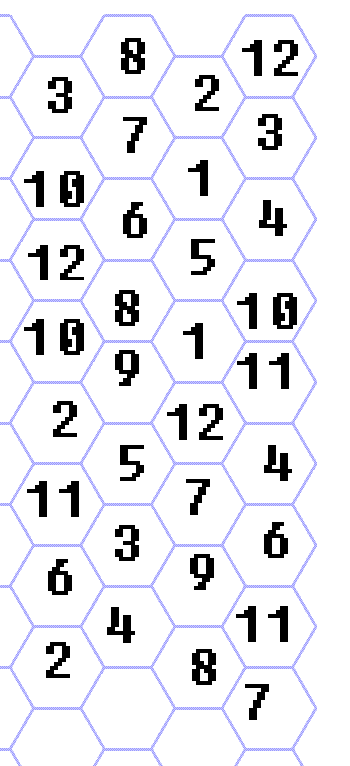March 30th, 2011 at 10:42:40 AM
permalink
Imagine a numerical layout on a table, where you can bet on the outcome of a wheel's spin. There are 12 numbers on the wheel. You should be able to place a chip on the border of two neighboring cells on the layout to bet on two numbers, and every number pair is available.
I am looking to fill a hex grid of arbitrary shape and size with the numbers 1-12.
Example:
In the above hex grid, the number (01) is neighbored by every other number (02)..(12). There is a duplicate neighboring pair, as (01) touches (02) in two different places.
The grid can expand in any direction, and need not be of a regular shape. I believe there is something to be said about numerical symmetry in this project. I might prefer something that might take up only 4 or 5 total rows, but any solution would be nice to look at.
Anyone have an algorithm or pattern they could suggest to help me solve this myself? I'm still plugging away at it, but ideas are appreciated.
Would there be another more elegant solution to minimize table space besides a hex grid?
I am looking to fill a hex grid of arbitrary shape and size with the numbers 1-12.
- Numbers may (and should) repeat
- Each number should touch every other number at least once (with least number of repetitions)
- Numbers need not touch themselves (i.e. don't need 5 neighboring a 5)
Example:
(06)(07)(08)(09)
(05)(01)(02)(01)(10)
(04)(03)(12)(11) The grid can expand in any direction, and need not be of a regular shape. I believe there is something to be said about numerical symmetry in this project. I might prefer something that might take up only 4 or 5 total rows, but any solution would be nice to look at.
Anyone have an algorithm or pattern they could suggest to help me solve this myself? I'm still plugging away at it, but ideas are appreciated.
Would there be another more elegant solution to minimize table space besides a hex grid?
-Dween!
March 30th, 2011 at 11:31:51 AM
permalink
Interesting problem. What you're really trying to do is form a grid with all possible (66) edges between numbers. Perhaps there's a solution where you start with those 66 combinations and back into it? I'm thinking there may be a clever way to lay out the 66 combos and then form the dual of a connectivity graph to get your answer, but I haven't tried.
Edit: does the grid need to contain only regular polygons? Do all polygons need to be identical?
Edit: does the grid need to contain only regular polygons? Do all polygons need to be identical?
"In my own case, when it seemed to me after a long illness that death was close at hand, I found no little solace in playing constantly at dice."
-- Girolamo Cardano, 1563
March 30th, 2011 at 11:58:15 AM
permalink
I would suggest using a "triangle" or "wedge" configuration with each column representing the lower number in the combo, and the row representing the higher.
1-2
1-3, 2-3
1-4, 2-4, 3-4
1-5, 2-5, 3-5, 4-5
.
.
.
1-12, 2-12, 3-12, 4-12, 5-12.... 11-12
This layout makes it easier to find the combo I am interested in. Otherwise, I would have to search for the particular case on a layout without an easily discernable pattern, and multiple positions for the same combination.
Is it also necessary to have single numbers available? The column and row headers can be used for that purpose.
According to this entry in Wikipedia, it is not possible to realize this many edges in a polyhedron with equal sides, so it would require repeating some of the numbers to cover all the combinations at least once.
1-2
1-3, 2-3
1-4, 2-4, 3-4
1-5, 2-5, 3-5, 4-5
.
.
.
1-12, 2-12, 3-12, 4-12, 5-12.... 11-12
This layout makes it easier to find the combo I am interested in. Otherwise, I would have to search for the particular case on a layout without an easily discernable pattern, and multiple positions for the same combination.
Is it also necessary to have single numbers available? The column and row headers can be used for that purpose.
According to this entry in Wikipedia, it is not possible to realize this many edges in a polyhedron with equal sides, so it would require repeating some of the numbers to cover all the combinations at least once.
Simplicity is the ultimate sophistication - Leonardo da Vinci
March 30th, 2011 at 12:06:01 PM
permalink
A good point. I am not seeing a possible solution that doesn't have some pair-repeats. I don't know if there would be a unique solution, unless you just had a long string of adjacent hexagons, versus a cluster.Quote: AyecarumbaI would suggest using a "triangle" or "wedge" configuration...
Otherwise, I would have to search for the particular case on a layout without an easily discernable pattern, and multiple positions for the same combination.
As for ease of locating pairs, I can see that being an issue as well. This would be used at a carnival/funfair, so neatness was not one of the criteria I was originally looking for.
-Dween!



